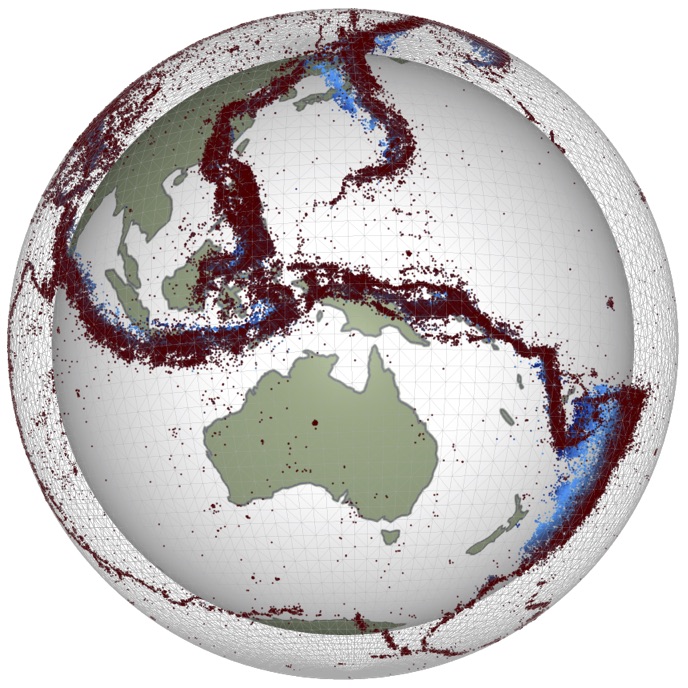Linear diffusion of a hot pipe#
Using the adv_diff solver.
No advection as the velocity field is not updated (and set to 0).
Benchmark comparison between 1D numerical solution and 2D UW model.
# to fix trame issue
import nest_asyncio
nest_asyncio.apply()
# %%
from petsc4py import PETSc
import underworld3 as uw
from underworld3.systems import Stokes
import numpy as np
import sympy
from mpi4py import MPI
import math
if uw.mpi.size == 1:
import matplotlib.pyplot as plt
# %%
sys = PETSc.Sys()
sys.pushErrorHandler("traceback")
# %%
# Set the resolution.
res = 32
xmin, xmax = 0.0, 1.0
ymin, ymax = 0.0, 1.0
pipe_thickness = 0.4 ###
# %%
k0 = 1e-6 ### m2/s (diffusivity)
l0 = 1e5 ### 100 km in m (length of box)
time_scale = l0**2 / k0 ### s
time_scale_Myr = time_scale / (60 * 60 * 24 * 365.25 * 1e6)
mesh = uw.meshing.UnstructuredSimplexBox(minCoords=(xmin, ymin), maxCoords=(xmax, ymax), cellSize=1.0 / res, regular=True)
mesh = uw.meshing.StructuredQuadBox(
elementRes=(int(res), int(res)), minCoords=(xmin, ymin), maxCoords=(xmax, ymax)
)
Create adv_diff object
# Set some things
k = 1.0
tmin = 0.5
tmax = 1.0
# Create an adv
v = uw.discretisation.MeshVariable("U", mesh, mesh.dim, degree=2)
T = uw.discretisation.MeshVariable("T", mesh, 1, degree=1)
adv_diff = uw.systems.AdvDiffusionSLCN(
mesh,
u_Field=T,
V_fn=v,
solver_name="adv_diff",
)
adv_diff.constitutive_model = uw.constitutive_models.DiffusionModel
adv_diff.constitutive_model.Parameters.diffusivity = k
# %%
### fix temp of top and bottom walls
adv_diff.add_dirichlet_bc(0.5, "Bottom", 0)
adv_diff.add_dirichlet_bc(0.5, "Top", 0)
# %%
maxY = mesh.data[:, 1].max()
minY = mesh.data[:, 1].min()
with mesh.access(T):
T.data[...] = tmin
pipePosition = ((maxY - minY) - pipe_thickness) / 2.0
T.data[
(mesh.data[:, 1] >= (mesh.data[:, 1].min() + pipePosition))
& (mesh.data[:, 1] <= (mesh.data[:, 1].max() - pipePosition))
] = tmax
# %%
def plot_fig():
if uw.mpi.size == 1:
import pyvista as pv
import underworld3.visualisation as vis
pvmesh = vis.mesh_to_pv_mesh(mesh)
pvmesh.point_data["T"] = vis.scalar_fn_to_pv_points(pvmesh, T.sym)
velocity_points = vis.meshVariable_to_pv_cloud(v)
velocity_points.point_data["V"] = vis.vector_fn_to_pv_points(velocity_points, v.sym)
pl = pv.Plotter(window_size=(750, 750))
pl.add_mesh(pvmesh, "Black", "wireframe")
# pvmesh.point_data["rho"] = uw.function.evaluate(density, mesh.data)
pl.add_mesh(
pvmesh,
cmap="coolwarm",
edge_color="Black",
show_edges=True,
scalars="T",
use_transparency=False,
opacity=0.95,
)
# pl.add_mesh(pvmesh, cmap="coolwarm", edge_color="Black", show_edges=True, scalars="S",
# use_transparency=False, opacity=0.5)
# pl.add_mesh(
# point_cloud,
# cmap="coolwarm",
# edge_color="Black",
# show_edges=False,
# scalars="M",
# use_transparency=False,
# opacity=0.95,
# )
pl.add_arrows(velocity_points.points, velocity_points.point_data["V"], mag=5.0, opacity=0.5)
# pl.add_arrows(arrow_loc2, arrow_length2, mag=1.0e-1)
# pl.add_points(pdata)
pl.show(cpos="xy")
# return vsol
plot_fig()
Vertical profile across the centre of the box#
### y coords to sample
sample_y = np.arange(
mesh.data[:, 1].min(), mesh.data[:, 1].max(), mesh.get_min_radius()
) ### Vertical profile
### x coords to sample
# sample_x = np.repeat(mesh.data[:,0].min(), sample_y.shape[0]) ### LHS wall
sample_x = np.zeros_like(sample_y) ### centre of the box
sample_points = np.empty((sample_x.shape[0], 2))
sample_points[:, 0] = sample_x
sample_points[:, 1] = sample_y
t0 = uw.function.evaluate(adv_diff.u.fn, sample_points)
# %%
### estimate the timestep based on diffusion only
dt = mesh.get_min_radius() ** 2 / k ### dt = length squared / diffusivity
# print(f'dt: {dt*time_scale_Myr} Myr')
print(f"dt: {dt*time_scale_Myr}")
# %%
def diffusion_1D(sample_points, tempProfile, k, model_dt):
x = sample_points
T = tempProfile
dx = sample_points[1] - sample_points[0]
dt = 0.5 * (dx**2 / k)
""" max time of model """
total_time = model_dt
""" get min of 1D and 2D model """
time_1DModel = min(model_dt, dt)
""" determine number of its """
nts = math.ceil(total_time / time_1DModel)
""" get dt of 1D model """
final_dt = total_time / nts
for i in range(nts):
qT = -k * np.diff(T) / dx
dTdt = -np.diff(qT) / dx
T[1:-1] += dTdt * final_dt
return T
### get the initial temp profile
tempData = uw.function.evaluate(adv_diff.u.fn, sample_points)
step = 0
time = 0.0
# %%
nsteps = 1 # 21
if uw.mpi.size == 1:
"""create figure to show the temp diffuses"""
plt.figure(figsize=(9, 3))
plt.plot(t0, sample_points[:, 1], ls=":")
while step < nsteps:
### print some stuff
if uw.mpi.rank == 0:
# print(f"Step: {str(step).rjust(3)}, time: {time*time_scale_Myr:6.2f} [MYr]")
print(f"Step: {str(step).rjust(3)}, time: {time:6.5f}")
### 1D profile from underworld
t1 = uw.function.evalf(adv_diff.u.sym[0], sample_points)
if uw.mpi.size == 1 and step % 10 == 0:
"""compare 1D and 2D models"""
plt.figure()
### profile from UW
plt.plot(t1, sample_points[:, 1], ls="-", c="red", label="2D linear model")
### numerical solution
plt.plot(tempData, sample_points[:, 1], ls=":", c="k", label="1D linear model")
plt.legend()
plt.show()
### 1D diffusion
tempData = diffusion_1D(
sample_points=sample_points[:, 1], tempProfile=tempData, k=k, model_dt=dt
)
### diffuse through underworld
adv_diff.solve(timestep=dt)
step += 1
time += dt

